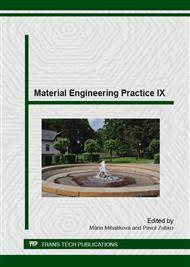p.13
p.18
p.22
p.26
p.30
p.35
p.41
p.45
p.51
The Parameters Affecting Strength Calculation of Gears
Abstract:
Safety and traffic flow of production facilities also depends upon the reliability of technical security equipment. Gearing in the transmission mechanisms must satisfy the conditions of strength calculation. This calculation consists of checking of the gear teeth on bend and contact. From the stress of gears is show that the basic requirements of the material are high hardness of works surfaces and bending strength. Steels best meet these conditions. Used steel with surface hardness up to 350 HBW, or heat treated steel with hardness of 500-650 HBW. The advantage of these materials is the high value of the contact pressure in the tough centre core of the tooth. As a final heat treatment are used surface hardening, cementation and hardening, nitridation and carbo-nitridation. Good properties of heat-treated steels are at the correct thickness of the heat-treated layer of the tooth. This paper considers the appropriate choice of parameters to obtain the desired level of safety of gears in a gearbox to drive the conveyor in the metallurgical industry under increased load.
Info:
Periodical:
Pages:
30-34
Citation:
Online since:
December 2014
Authors:
Keywords:
Price:
Сopyright:
© 2015 Trans Tech Publications Ltd. All Rights Reserved
Share:
Citation:


